
- •Functions
- •The Concept of a Function
- •Trigonometric Functions
- •Inverse Trigonometric Functions
- •Logarithmic, Exponential and Hyperbolic Functions
- •Limits and Continuity
- •Introductory Examples
- •Continuity Examples
- •Linear Function Approximations
- •Limits and Sequences
- •Properties of Continuous Functions
- •The Derivative
- •The Chain Rule
- •Higher Order Derivatives
- •Mathematical Applications
- •Antidifferentiation
- •Linear Second Order Homogeneous Differential Equations
- •Linear Non-Homogeneous Second Order Differential Equations
- •Area Approximation
- •Integration by Substitution
- •Integration by Parts
- •Logarithmic, Exponential and Hyperbolic Functions
- •The Riemann Integral
- •Volumes of Revolution
- •Arc Length and Surface Area
- •Techniques of Integration
- •Integration by formulae
- •Integration by Substitution
- •Integration by Parts
- •Trigonometric Integrals
- •Trigonometric Substitutions
- •Integration by Partial Fractions
- •Fractional Power Substitutions
- •Numerical Integration
- •Integrals over Unbounded Intervals
- •Discontinuities at End Points
- •Improper Integrals
- •Sequences
- •Monotone Sequences
- •Infinite Series
- •Series with Positive Terms
- •Alternating Series
- •Power Series
- •Taylor Polynomials and Series
- •Applications
- •Parabola
- •Ellipse
- •Hyperbola
- •Polar Coordinates
- •Graphs in Polar Coordinates
- •Areas in Polar Coordinates
- •Parametric Equations
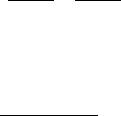
2.2. LINEAR FUNCTION APPROXIMATIONS |
61 |
||||||
25. f(x) = 2 |
x − 1 |
− |
x − 2 |
26. f(x) = |
x |
|
|
|x − 1| |
|x − 2| |
x2 − 9 |
|||||
|
|
||||||
|
|
x2 + 1 |
for x > 0 |
|
27. |
f(x) = |
|
2x |
for x ≤ 0 |
29. |
f(x) = |
|
x − 1 |
|
|
(x − 2)(x − 3) |
|||
|
|
|
||
Recall the unit step function u(x) =
28. f(x) =
30. f(x) =
0 if x < 0
1 if x ≥ 0.
sin |
x |
if x > 0 |
sin x2 |
if x ≤ 0 |
|
|
|
|
||x − 2| |
if x > 1 |
x − 1| |
if x ≤ 1 |
Sketch the graph of each of the following functions and determine the left hand limit and the right hand limit at each point of discontinuity of f and g.
31.f(x) = 2u(x − 3) − u(x − 4)
32.f(x) = −2u(x − 1) + 4u(x − 5)
33.f(x) = u(x − 1) + 2u(x + 1) − 3u(x − 2)
34. |
f(x) = sin x hu x + |
π |
− u x − |
|
π |
i |
|||||
|
|
|
|||||||||
2 |
2 |
||||||||||
35. |
g(x) = (tan x) hu x + |
π |
− u |
x |
− |
|
π |
i |
|||
|
|
|
|
||||||||
2 |
2 |
||||||||||
36.f(x) = [u(x) − u(x − π)] cos x
2.2Linear Function Approximations
One simple application of limits is to approximate a function f(x), in a small neighborhood of a point c, by a line. The approximating line is called the tangent line. We begin with a review of the equations of a line.
A vertical line has an equation of the form x = c. A vertical line has no slope. A horizontal line has an equation of the form y = c. A horizontal line has slope zero. A line that is neither horizontal nor vertical is called an oblique line.
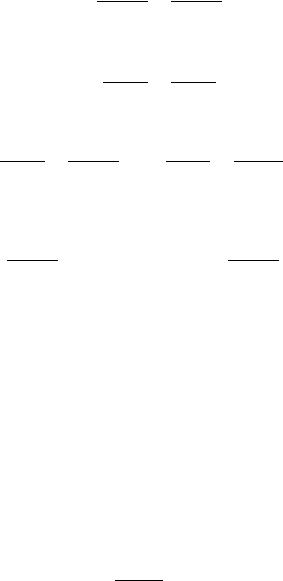
62 |
CHAPTER 2. LIMITS AND CONTINUITY |
Suppose that an oblique line passes through two points, say (x1, y1) and (x2, y2). Then the slope of this line is define as
m = y2 − y1 = y1 − y2 . |
|
x2 − x1 |
x1 − x2 |
If (x, y) is any arbitrary point on the above oblique line, then
m = y − y1 = y − y2 . |
|
x − x1 |
x − x2 |
By equating the two forms of the slope m we get an equation of the line:
y − y1 |
= |
y2 − y1 |
or |
y − y2 |
= |
y2 − y1 |
. |
|
x2 − x1 |
|
|
||||
x − x1 |
|
x − x2 |
x2 − x1 |
||||
On multiplying through, we get the “two point” form of the equation of the line, namely,
y |
− |
y |
|
= |
y2 − y1 |
(x |
− |
x |
) or y |
− |
y |
|
= |
y2 − y1 |
(x |
− |
x |
). |
|
|
1 |
|
x2 − x1 |
1 |
|
|
2 |
|
x2 − x1 |
2 |
|
||||||
Example 2.2.1 Find the equations of the lines passing through the following pairs of points:
(i) (4, 2) and (6, 2) |
(ii) (1, 3) and (1, 5) |
(iii) (3, 4) and (5, −2) |
(iv) (0, 2) and (4, 0). |
Part (i) Since the y-coordinates of both points are the same, the line is horizontal and has the equation y = 2. This line has slope 0.
Part (ii) Since the x-coordinates of both points are equal, the line is vertical and has the equation x = 1.
Part (iii) The slope of the line is given by
−2 − 4
m = 5 − 3 = −3.
The equation of this line is
y − 4 = −3(x − 3) or y + 2 = −3(x − 5).

2.2. LINEAR FUNCTION APPROXIMATIONS |
63 |
|
On solving for y, we get the equation of the line as |
|
|
y = −3x + |
13. |
|
This line goes through the point (0, 13). |
The number 13 is called the y- |
|
intercept. The above equation is called the slope-intercept form of the line.
Example 2.2.2 Determine the equations of the lines satisfying the given conditions:
(i)slope = 3, passes through (2, 4)
(ii)slope = −2, passes through (1, −3)
(iii)slope = m, passes through (x1, y1)
(iv)passes through (3, 0) and (0, 4)
(v)passes through (a, 0) and (0, b)
Part (i) If (x, y) is on the line, then we equate the slopes and simplify:
3 = |
y − 4 |
or y |
− |
4 = 3(x |
− |
2). |
||
|
x |
− |
2 |
|
|
|
||
|
|
|
|
|
|
|
|
|
Part (ii) If (x, y) is on the line, then we equate slopes and simplify:
y + 3 |
or y + 3 = −2(x − 1). |
−2 = x − 1 |
Part (iii) On equating slopes and clearing fractions, we get
m = |
y − y1 |
or y |
− |
y |
|
= m(x |
− |
x |
). |
|
x − x1 |
|
1 |
|
1 |
|
|||
This form of the line is called the “point-slope” form of the line.

64 |
|
|
|
|
|
CHAPTER 2. LIMITS AND CONTINUITY |
||||||||
Part (iv) Using the two forms of the line we get |
||||||||||||||
|
y − 0 |
= |
4 − 0 |
|
or y = |
|
4 |
(x 3). |
||||||
|
|
|
|
|||||||||||
|
x |
− |
3 |
|
0 |
− |
3 |
|
|
|
−3 − |
|||
|
|
|
|
|
|
|
||||||||
If we divide by 4 we get |
|
|
|
|
x |
|
y |
|
|
|
|
|||
|
|
|
|
|
|
|
+ |
= 1. |
|
|
|
|||
|
|
|
|
|
|
|
3 |
|
|
|
|
|
||
|
|
|
|
|
|
|
|
4 |
|
|
|
|
||
The number 3 is called the x-intercept and the number 4 is called the y- intercept of the line. This form of the equation is called the “two-intercept” form of the line.
Part (v) As in Part (iv), the “two-intercept” form of the line has the equation
xa + yb = 1.
In order to approximate a function f at the point c, we first define the slope m of the line that is tangent to the graph of f at the point (c, f(c)).
graph
m = lim |
f(x) − f(c) |
. |
x→c |
x − c |
|
Then the equation of the tangent line is
y − f(c) = m(x − c),
written in the point-slope form. The point (c, f(c)) is called the point of tangency. This tangent line is called the linear approximation of f about x = c.
Example 2.2.3 Find the equation of the line tangent to the graph of f(x) = x2 at the point (2, 4).
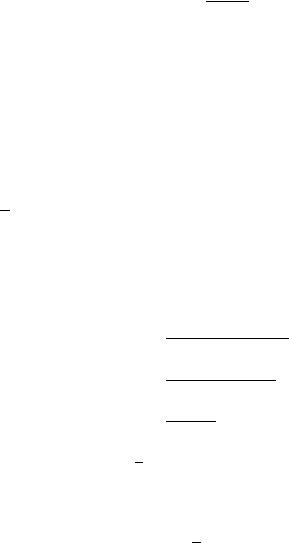
2.2. LINEAR FUNCTION APPROXIMATIONS |
65 |
The slope m of the tangent line at (3, 9) is
m = lim x2 − 9
x→3 x − 3
= lim (x + 3)
x→3
= 6.
The equation of the tangent line at (3, 9) is
y − 9 = 6(x − 3).
Example 2.2.4 Obtain the equation of the line tangent to the graph of
√
f(x) = x at the point (9, 3).
The slope m of the tangent line is given by
m = lim
x→9
= lim
x→9
= lim
x→9
= lim
x→9
= 16.
√ |
|
|
|
− 3 |
|
|
|
|
|
|
|||
x |
|
|
|
|
|
|
|||||||
x − 9 |
|
|
|
|
|
|
|
||||||
√ |
|
|
|
|
√ |
|
|
|
|||||
( x − 3)( |
|
|
|
x + 3) |
|||||||||
|
|
|
|
|
|
|
√ |
|
|
|
|
|
|
(x − 9)( |
|
x + 3) |
|||||||||||
|
|
|
|
|
|
x − 9 |
|
|
|
|
|
||
|
|
|
|
|
|
|
√ |
|
|
|
|
|
|
(x − 9)( |
x + 3) |
||||||||||||
1 |
|
|
|
|
|
|
|
||||||
√ |
|
+ 3 |
|
|
|
|
|
|
|
||||
x |
|
|
|
|
|
|
|
||||||
The equation of the tangent line is
y − 3 = 16(x − 9).
Example 2.2.5 Derive the equation of the line tangent to the graph of
|
|
|
1 |
|
|
f(x) = sin x at |
|
π |
, |
. |
|
|
6 |
|
2 |
||
The slope m of the tangent line is given by
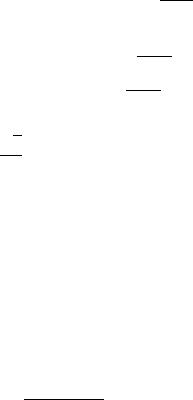
66 |
CHAPTER 2. LIMITS AND CONTINUITY |
x→ |
π6 |
|
x − π6 |
|
|
|
|
|
||||
m = lim |
sin x |
− sin |
|
π6 |
|
|
|
|
|
|||
|
|
|
|
|
x−π/6 |
|
||||||
= |
π |
|
|
|
||||||||
|
|
2 cos |
|
x+π/6 |
sin |
|
||||||
lim |
|
|
2 |
|
|
|
|
2 |
|
|
||
|
|
|
(x |
− π/6) |
|
|
|
|||||
x→ 6 |
|
|
|
|
|
|
||||||
|
|
|
|
|
|
|
|
|
π/6 |
|||
= cos(π/6) |
· |
lim |
sin |
x−2 |
|
|||||||
|
|
|
x→π6 |
|
|
|
|
|||||
|
|
|
|
|
x−π/6 |
|
|
|
||||
|
|
|
|
|
|
|
2 |
|
|
|
||
=cos(π/6)
√
=23.
The equation of the tangent line is
|
1 |
|
√ |
|
|
x − |
π |
. |
|
|
|||||||
y − |
|
= |
3 |
|
||||
2 |
2 |
6 |
||||||
Example 2.2.6 Derive the formulas for the slope and the equation of the line tangent to the graph of f(x) = sin x at (c, sin c).
As in Example 27, replacing π/6 by c, we get
m = lim |
sin x − sin c |
|
|
|
|
|
|
|
|||||
x→c |
x − c |
|
|
|
x−c |
|
|
|
|
||||
= x→c |
2 cos |
x+c |
|
sin |
|
|
|
||||||
|
x |
|
c |
2 |
|
|
|
||||||
lim |
|
|
2 |
|
|
|
|
|
|
|
|
|
|
|
|
− |
|
|
|
|
|
|
|
|
|||
x→c |
|
x + c |
· |
x→c |
sin |
x−c |
|||||||
|
2 |
|
|
|
x−2 c |
|
|||||||
= lim cos |
|
|
|
|
|
lim |
|
|
2 |
|
|||
|
|
|
|
|
|
|
|
|
|
||||
= cos c. |
|
|
|
|
|
|
|
|
|
||||
Therefore the slope of the line tangent to the graph of f(x) = sin x at (c, sin c) is cos c.
The equation of the tangent line is
y − sin c = (cos c)(x − c).

2.2. LINEAR FUNCTION APPROXIMATIONS |
67 |
Example 2.2.7 Derive the formulas for the slope, m, and the equation of the line tangent to the graph of f(x) = cos x at (c, cos c). Then determine
the slope and the equation of the tangent line at |
π |
, |
1 |
. |
|
|
|||
3 |
2 |
As in Example 28, we replace the sine function with the cosine function,
m = lim |
|
cos x − cos c |
|
|
|
|
|
|
|
|
|
||||
x→c |
|
x − c |
|
c |
|
x−c |
|
|
|
||||||
= x→c |
|
|
|
x+c |
|
|
|||||||||
|
−2 sin |
x |
|
2 |
|
|
|||||||||
lim |
|
|
|
|
− |
|
|
|
sin |
|
x−c |
|
|||
|
|
|
|
|
|
|
|
|
|||||||
= x→c |
|
|
x + c |
|
|
|
|
|
|||||||
|
|
2 |
x→c |
|
|
|
x−2 c |
|
|||||||
lim |
sin |
|
|
|
|
|
lim |
|
|
|
2 |
|
|||
|
|
|
|
|
|
|
|
|
|
|
|
|
|
|
|
= − sin(c).
The equation of the tangent line is
y − cos c = − sin c(x − c).
|
π |
|
|
π |
= − |
√ |
|
|
|
|
|
|
|
|
|||
|
|
|
|
|
|||||||||||||
For c = |
|
, slope = − sin |
|
3 |
|
and the equation of the tangent line |
|||||||||||
3 |
3 |
2 |
|||||||||||||||
|
|
|
|
|
|
1 |
|
|
√ |
|
|
x − |
π |
. |
|||
|
|
|
|
|
|
|
|
||||||||||
|
|
|
y − |
|
= − |
3 |
|
||||||||||
|
|
|
2 |
2 |
3 |
||||||||||||
Example 2.2.8 Derive the formulas for the slope, m, and the equation of the line tangent to the graph of f(x) = xn at the point (c, cn), where n is a natural number. Then get the slope and the equation of the tangent line for c = 2, n = 4.
By definition, the slope m is given by
m = lim |
xn − cn |
. |
x→c |
x − c |
|
To compute this limit for the general natural number n, it is convenient to
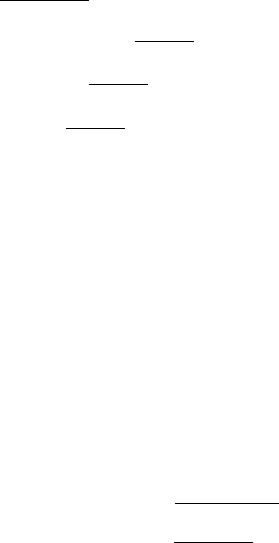
68 |
|
|
|
|
|
|
CHAPTER 2. LIMITS AND CONTINUITY |
|||||||||||||
let x = c + h. Then |
|
|
|
|
|
|
|
|
|
|
|
|
|
|
|
|
||||
m = lim |
|
(c + h)n − cn |
|
|
|
|
|
|
|
|
|
|
|
|
|
|
||||
h→0 |
|
h |
h |
2! |
|
|
|
|
|
|
· · · |
|
− |
|
||||||
h→0 |
|
|
|
|
|
|
|
|
|
|
|
|
|
|||||||
= lim |
1 |
|
cn + ncn−1h + |
n(n − 1) |
cn−2h2 + |
|
+ hn |
|
cn |
|||||||||||
|
|
|
|
|
|
|
||||||||||||||
h→0 |
|
h |
|
2! |
|
|
|
|
|
|
· · · |
|
|
|
|
|||||
= lim |
1 |
|
ncn−1h + |
n(n − 1) |
cn−2h2 |
+ |
|
+ hn |
|
|
|
|||||||||
|
|
|
|
|
|
|
||||||||||||||
h→0 |
|
2! |
|
|
|
· · · |
|
|
|
|
|
|
||||||||
= lim |
|
ncn−1 |
+ |
n(n − 1) |
cn−2h + |
|
|
|
+ hn−1 |
|
|
|
|
|||||||
|
|
|
|
|
|
|
|
|
||||||||||||
= ncn−1.
Therefore, the equation of the tangent line through (c, cn) is
y − cn = ncn−1(x − c).
For n = 4 and c = 2, we find the slope, m, and equation for the tangent line to the graph of f(x) = x4 at c = 2:
m = 4c3 = 32
y − 24 = 32(x − 2) or y − 16 = 32(x − 2).
Definition 2.2.1 Suppose that a function f is defined on a closed interval [a, b] and a < c < b. Then c is called a critical point of f if the slope of the line tangent to the graph of f at (c, f(c)) is zero or undefined. The slope function of f at c is defined by
slope (f(x), c) = lim |
f(c + h) − f(c) |
||
h |
|||
h→0 |
|||
= lim |
f(x) − f(c) |
. |
|
x→c |
x − c |
||
Example 2.2.9 Determine the slope functions and critical points of the following functions:
(i) |
f(x) = sin x, 0 |
≤ |
x |
≤ |
2π |
(ii) |
( ) = |
3 |
≤ |
x |
≤ |
2π |
|
|
f x |
cos x, 0 |
|
|
|||||||
(iii) |
f(x) = |x|, −1 ≤ x ≤ 1 |
(iv) |
f(x) = x − 4x, −2 ≤ x ≤ 2 |
|||||||||

2.2. LINEAR FUNCTION APPROXIMATIONS |
69 |
Part (i) In Example 28, we derived the slope function formula for sin x, namely
slope (sin x, c) = cos c.
Since cos c is defined for all c, the non-end point critical points on [0, 2π] are π/2 and 3π/2 where the cosine has a zero value. These critical points correspond to the maximum and minimum values of sin x.
Part (ii) In Example 29, we derived the slope function formula for cos x, namely
slope (cos x, c) = − sin c.
The critical points are obtained by solving the following equation for c:
− sin c = 0, 0 ≤ c ≤ 2π c = 0, π, 2π.
These values of c correspond to the maximum value of cos x at c = 0 and 2π, and the minimum value of cos x at c = π.
Part (iii) slope ( x |
, c) = lim |
|x| − |c| |
|
|
|
|
|
||||||||
| | |
|
x |
→ |
c |
x |
− |
c |
|
|
|
|
|
|||
|
|
|
|
|
|
|
|
|
|
|
|
|
|||
|
= lim |
|x| − |c| |
· |
|
|x| + |c| |
||||||||||
|
x − c |
|x| + |c| |
|||||||||||||
|
|
x→c |
|
||||||||||||
|
= lim |
(x |
− |
x2 − c2 |
) |
||||||||||
|
|
x→c |
|
c)( x |
+ c |
||||||||||
|
|
|
|
|
|
|
|
|
|
| |
| |
| | |
|
||
|
= lim |
x + c |
|
|
|
|
|
||||||||
|
|
|
|
|
|
|
|
|
|
||||||
|
|x| + |c| |
|
|
|
|
|
|||||||||
|
|
x→c |
|
|
|
|
|
||||||||
|
= |
|
2c |
|
|
|
|
|
|
|
|
|
|||
|
|
|
|
|
|
|
|
|
|
|
|
|
|
||
|
|
2|c| |
|
|
|
|
|
|
|
|
|
||||
|
= |
|
c |
|
|
|
|
|
|
|
|
|
|
|
|
|
|
|
|
|
|
|
|
|
|
|
|
|
|
||
|
|
|c| |
|
|
|
|
|
|
|
|
|
|
|
||
|
= |
−1 |
|
|
|
|
|
if c < 0 |
|||||||
|
|
|
|
|
1 |
|
|
|
|
|
|
if c > 0 |
|||
|
|
undefined |
|
if c = 0 |
|||||||||||
|
|
|
|
|
|
|
|
|
|
|
|
|
|
||
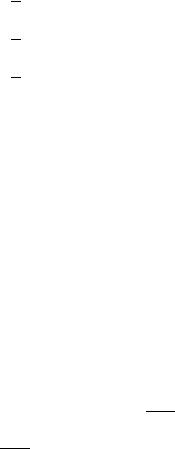
70 |
CHAPTER 2. LIMITS AND CONTINUITY |
The only critical point is c = 0, where the slope function is undefined. This critical point corresponds to the minimum value of |x| at c = 0. The slope function is undefined because the tangent line does not exist at c = 0. There is a sharp corner at c = 0.
Part (iv) The slope function for f(x) = x3 − 4x is obtained as follows:
slope (f(x), c) = lim 1 [((c + h)3 − 4(c + h)) − (c3 − 4c)]
h→0 h
= lim 1 [c3 + 3c2h + 3ch2 + h3 − 4c − 4h − c3 + 4c]
h→0 h
= lim 1 [3c2h + 3ch2 + h3 − 4h]
h→0 h
= lim [3c2 + 3ch + h2 − 4]
h→0
= 3c2 − 4
graph
The critical points are obtained by solving the following equation for c:
3c2 − 4 = 0
|
|
|
|
|
|
|
|
|
2 |
|
|
|
|
|
|
|
|
|
|
|
|
|
|
|
|
|
|
|
c = ±√ |
|
|
|
|
|
|
|
|
|
|
|
|
|
|
|
|
|
|
|
3 |
|
|
|
|
|
|
|
|
||
At c = |
−2 |
, f has a local maximum value of |
16 |
|
and at c = |
2 |
, f has a |
||||||||||||
|
√ |
|
|
|
|
|
|
|
|
|
|
√ |
|
|
|
√ |
|
|
|
|
3 |
|
|
√ |
|
|
|
3 |
3 |
|
3 |
|
|||||||
|
|
|
|
|
|
|
|
|
|
− |
|
|
|
|
|||||
local minimum value of |
−16 |
|
. The end point ( |
|
2, 0) has a local end-point |
||||||||||||||
|
|
|
|
|
|||||||||||||||
|
|
|
|
3 |
|
3 |
|
|
|
|
|
|
|
|
|
|
|
||
minimum and the end point (2, 0) has a local end-point maximum.
Remark 7 The zeros and the critical points of a function are helpful in sketching the graph of a function.
2.2. LINEAR FUNCTION APPROXIMATIONS |
71 |
Exercises 2.2
1.Express the equations of the lines satisfying the given information in the form y = mx + b.
(a)Line passing through (2, 4) and (5, −2)
(b)Line passing through (1, 1) and (3, 4)
(c)Line with slope 3 which passes through (2, 1)
(d)Line with slope 3 and y-intercept 4
(e)Line with slope 2 and x-intercept 3
(f)Line with x-intercept 2 and y-intercept 4.
2.Two oblique lines are parallel if they have the same slope. Two oblique lines are perpendicular if the product of their slopes is −1. Using this information, solve the following problems:
(a)Find the equation of a line that is parallel to the line with equation y = 3x − 2 which passes through (1, 4).
(b)Solve problem (a) when “parallel” is changed to “perpendicular.”
(c)Find the equation of a line with y-intercept 4 which is parallel to y = −3x + 1.
(d)Solve problem (c) when “parallel” is changed to “perpendicular.”
(e)Find the equation of a line that passes through (1, 1) and is
(i)parallel to the line with equation 2x − 3y = 6.
(ii)perpendicular to the line with equation 3x + 2y = 6
3.For each of the following functions f(x) and values c,
(i)derive the slope function, slope (f(x), c) for arbitrary c;
(ii)determine the equations of the tangent line and normal line (perpendicular to tangent line) at the point (c, f(c)) for the given c;
(iii)determine all of the critical points (c, f(c)).
(a) f(x) = x2 − 2x, c = 3
(b) f(x) = x3 , c = 1
